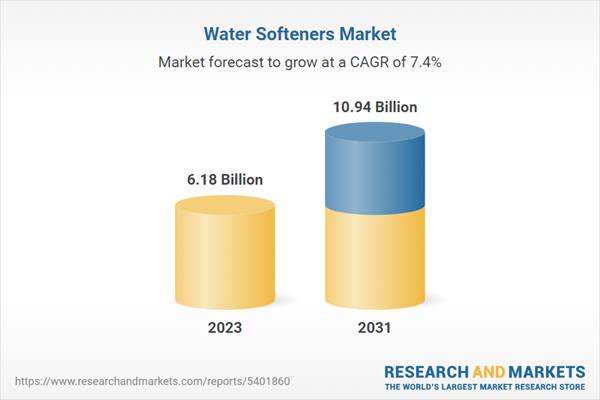Water softeners are gaining significant popularity due to their ability to remove minerals such as calcium and magnesium from water, preventing scale buildup and improving water quality. Urbanization, industrialization, the need for clean water, rising disposable income, and changing consumer preferences are among the major factors contributing to the water softeners market growth. Government regulations promoting water softeners to reduce water wastage also contribute to market expansion. Salt-based water softeners are the most widely used type. Among all major regions, North America and Europe lead the market due to high hard water prevalence. The water softeners market has witnessed significant growth in recent years, driven by increasing awareness about the detrimental effects of hard water on plumbing systems, appliances, and overall water quality. Hard water with high levels of calcium, magnesium, and other minerals poses challenges such as scale buildup and soap scum formation, lowering the efficiency of water heaters and washing machines. As a result, residential, commercial, and institutional consumers are increasingly adopting water-softening systems to overcome these issues.
Based on type, the market is bifurcated into salt-based water softeners and salt-free water softeners. The salt-free water softeners segment accounts for a significant share of the market. Salt-free water softeners, also known as descalers or water conditioners, offer an alternative to traditional salt-based systems for managing challenges posed by hard water. Unlike salt-based softeners that remove calcium and magnesium ions through ion exchange, salt-free systems utilize various technologies such as template-assisted crystallization (TAC), chelation, or catalytic conversion to alter the structure of hardness minerals, preventing them from adhering to surfaces and forming scale. In TAC systems, small crystals form on specially designed media within the softener, attracting and neutralizing calcium and magnesium ions, thereby inhibiting scale formation. Chelation involves the use of organic compounds that bind to hardness-causing minerals, preventing them from precipitating out of solution and forming scale deposits.
In 2023, Asia Pacific held a significant share of the water softeners market. With the rising population, water consumption is rapidly increasing across Asia Pacific. The burden on municipal water treatment plants across the region has significantly increased due to the need to fulfill the rising demand for drinking water and sanitary facilities. According to the Asian Development Bank, nearly3.40 billion people in Asia are estimated to live in water-stressed areas by 2050. Such stats emphasize the need to implement water recycling and reuse approaches, which is likely to drive the demand for water softeners over the coming years. Due to infrastructure limitations, municipal corporations in countries such as China and India are unable to efficiently handle hard water. Therefore, point-of-entry equipment, such as softeners, is being installed in residential settings to receive water of suitable quality.
Rheem Manufacturing Co, Marlo Inc, Robert B Hill Co, Silverline UK Ltd, Hobart Corp, Water-Right Inc, US Water Systems Inc, Kinetico Inc, Ecowater Systems LLC, and Culligan International Co are among the prominent players profiled in the water softeners market report. In addition, several other players have been studied and analyzed during the study to get a holistic view of the market and its ecosystem. The water softeners market report also includes company positioning and concentration to evaluate the performance of competitors/players in the market.
The overall global water softeners market size has been derived using both primary and secondary sources. To begin the research process, exhaustive secondary research has been conducted using internal and external sources to obtain qualitative and quantitative information related to the market. Also, multiple primary interviews have been conducted with industry participants to validate the data and gain more analytical insights into the topic. Participants in this process include industry experts such as VPs, business development managers, market intelligence managers, and national sales managers, along with external consultants such as valuation experts, research analysts, and key opinion leaders specializing in the water softeners market.
Table of Contents
Companies Mentioned
- Rheem Manufacturing Co
- Marlo Inc
- Robert B Hill Co
- Silverline UK Ltd
- Hobart Corp
- Water-Right Inc
- US Water Systems Inc
- Kinetico Inc
- Ecowater Systems LLC
- Culligan International Co
Table Information
| Report Attribute | Details |
|---|---|
| No. of Pages | 172 |
| Published | May 2024 |
| Forecast Period | 2023 - 2031 |
| Estimated Market Value ( USD | $ 6.18 Billion |
| Forecasted Market Value ( USD | $ 10.94 Billion |
| Compound Annual Growth Rate | 7.4% |
| Regions Covered | Global |
| No. of Companies Mentioned | 10 |









